As an Amazon Associate KitchenwareSets.com earns from qualifying purchases.
11 Genius Apartment Kitchen Design Ideas For Small Spaces
Struggling with a kitchen that feels more like a closet? You’re not alone.
Apartment kitchen design focuses on solving this exact problem. It’s all about making small, often rented, spaces both functional and beautiful. Many people feel frustrated by the lack of counter space and storage.
The solution to a cramped apartment kitchen is to maximize vertical space, choose scaled appliances, and implement multi-functional elements. This guide will show you 11 genius ideas to create a kitchen that you’ll love to cook in.
Is Your Small Kitchen Making You Feel Cramped and Uninspired?
That feeling of frustration is completely valid. A cramped, cluttered kitchen can make daily routines feel like a chore. When every countertop is covered and you can’t find the pot you need, it’s easy to feel uninspired. The good news is that these small kitchen problems are solvable. You don’t need a massive renovation or a huge budget to create a functional, stylish kitchen. With a few smart apartment kitchen design solutions, you can transform your space, whether you’re renting or you own your home. This guide is packed with brilliant, achievable ideas to get you started.
11 Genius Apartment Kitchen Design Ideas To Maximize Your Small Space
Ready for a change? We’ve curated a list of 11 designer-approved apartment kitchen solutions that are proven to work in small spaces. Each idea is a genius way to tackle common frustrations, from cluttered countertops to inadequate storage. Better yet, every single one includes a clear, step-by-step guide to make it easy to replicate. Prepare to be inspired to create a kitchen that is efficient, organized, and beautiful.
1. Go Vertical with Ceiling-High Shelving
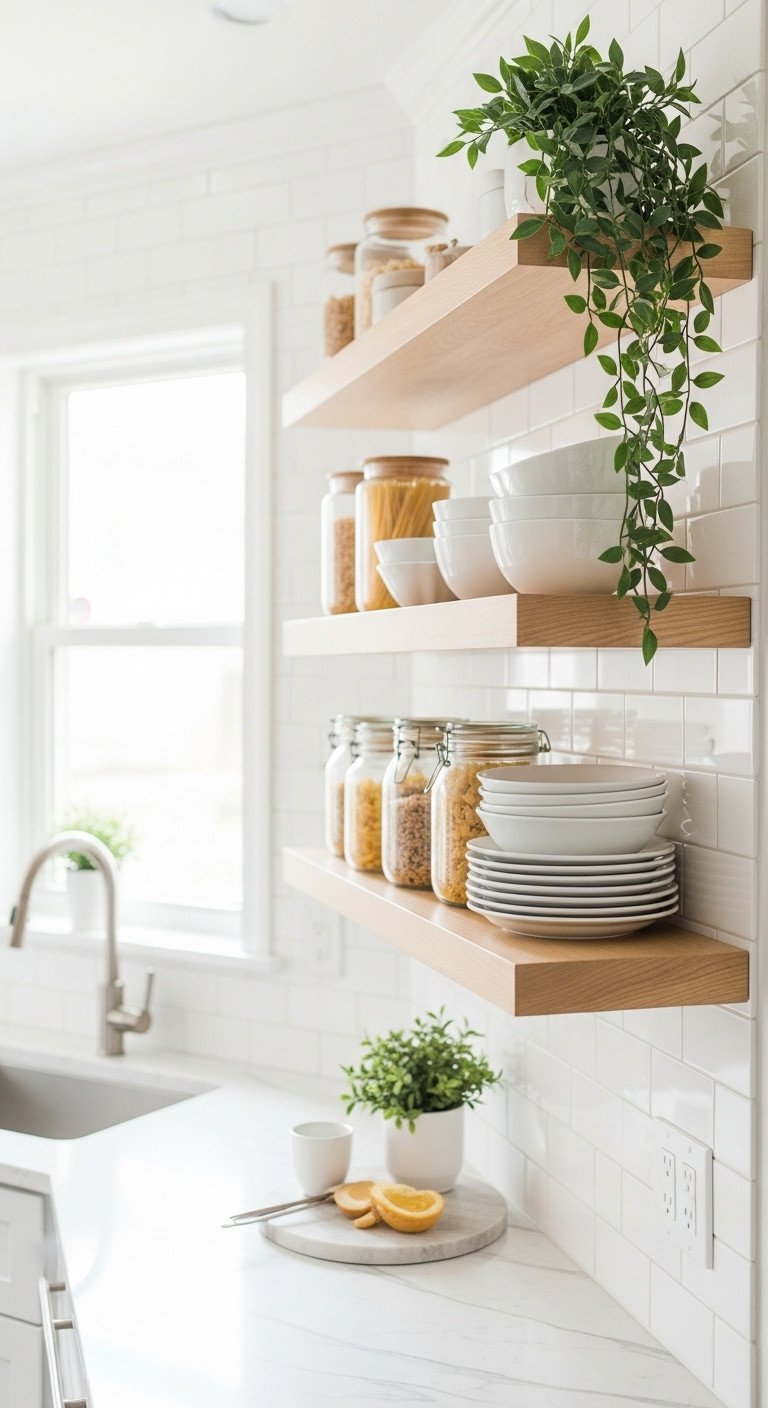
Pin this space-saving idea to your ‘Kitchen Goals’ board!
The fastest way to add storage without losing floor space is to think up. Open shelves that reach toward the ceiling draw the eye upward, making the room feel taller while providing accessible storage for dishes and pantry items. This approach transforms unused wall space into a functional and stylish display.
Materials Needed:
- Floating shelves (ensure they match your kitchen’s depth and style; recommend a slim profile)
- Heavy-duty floating shelf brackets rated for at least 50 pounds per shelf
- Stud finder
- Power drill with appropriate bits
- Level
- Measuring tape and pencil
Step-by-Step Directions:
- Plan Your Layout: Decide on the number of shelves and the spacing between them. Mark the desired height for the bottom shelf and use the level to draw a straight guide line.
- Locate Studs: Use a stud finder to locate the wall studs along your guide line. Mark each stud location. Securing shelves to studs is critical for safety and stability.
- Install Brackets: Drill pilot holes into the studs, then securely screw the brackets into the wall. Use your level to ensure they are perfectly straight.
- Attach Shelves: Place your shelves onto the brackets and secure them according to the manufacturer’s instructions, usually with small screws from underneath.
- Style Smartly: Place heavier items like stacks of plates closer to the brackets. Use the top, harder-to-reach shelves for decorative or less-frequently-used items.
Pro-Tip: Painting the shelves the same color as the wall can create a seamless, built-in look that makes the space feel even more open and less cluttered.
2. Implement a Magnetic Wall Organizer
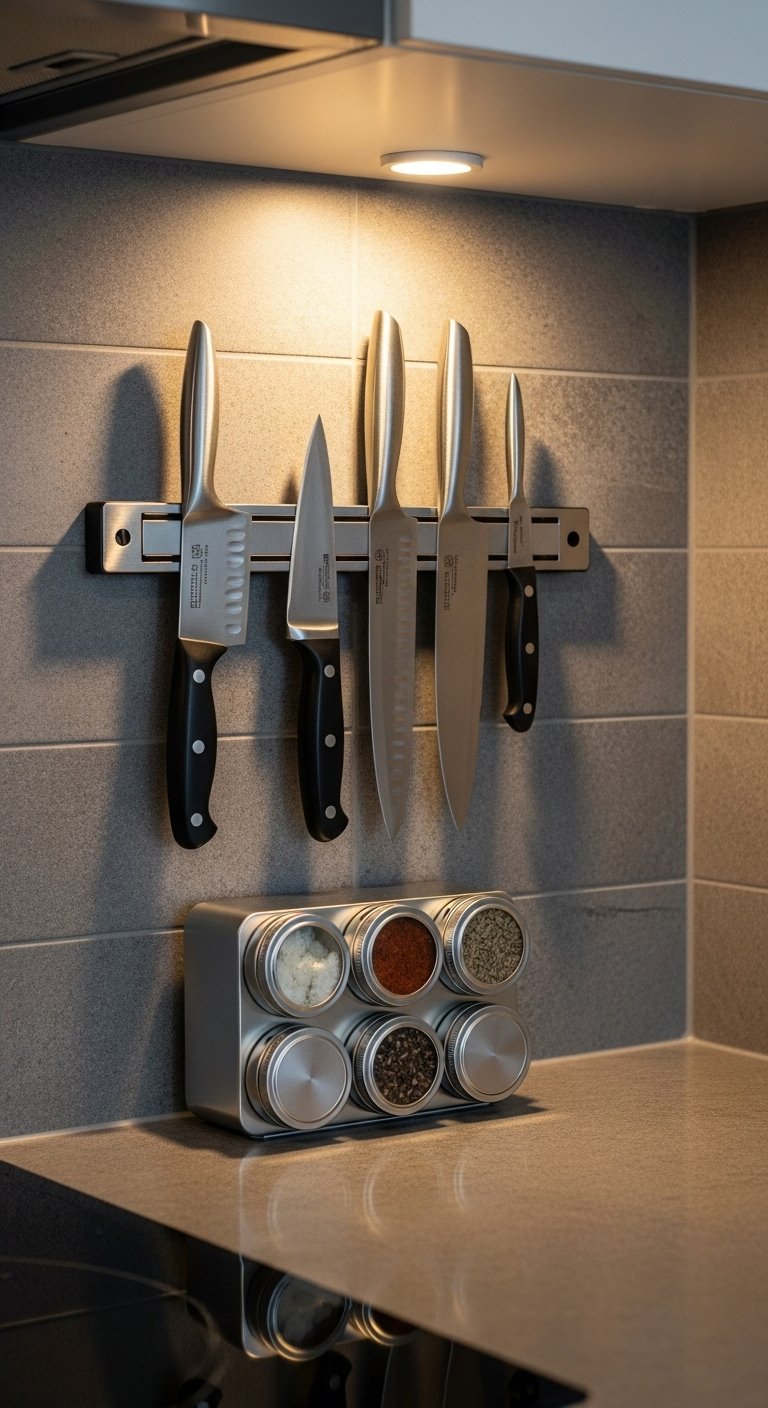
Save this genius idea to free up your countertops!
Counter space is gold in a small kitchen. A wall-mounted magnetic organizer is a simple solution to get bulky knife blocks and cluttered spice racks off your precious prep surfaces. This keeps essential tools and spices accessible while maintaining a clean, decluttered countertop.
Materials Needed:
- High-quality magnetic knife strip with a strong magnet (16-24 inches is a versatile size)
- Magnetic spice tins with clear lids
- Wall anchors and screws (if not mounting directly into studs)
- Drill, level, measuring tape, and pencil
Step-by-Step Directions:
- Choose a Location: Select a clear wall space that is easily accessible while cooking but safely out of the way of any direct heat or water source.
- Mark Your Holes: Hold the magnetic strip against the wall and use a level to ensure it’s straight. Use a pencil to mark where the mounting holes will go.
- Drill and Anchor: If not drilling into studs, drill holes for your wall anchors and gently tap them into place.
- Mount the Strip: Align the magnetic strip with your holes and screw it securely into the wall anchors or studs.
- Organize: Attach your knives, ensuring they are evenly spaced. Fill your magnetic tins with your most-used spices and arrange them on the wall nearby.
Lesson Learned: Don’t cheap out on the magnetic strip. A weak magnet is a safety hazard. Look for one with two magnetic rails for the most secure grip on heavier knives.
3. Use an Over-the-Sink Multipurpose Rack
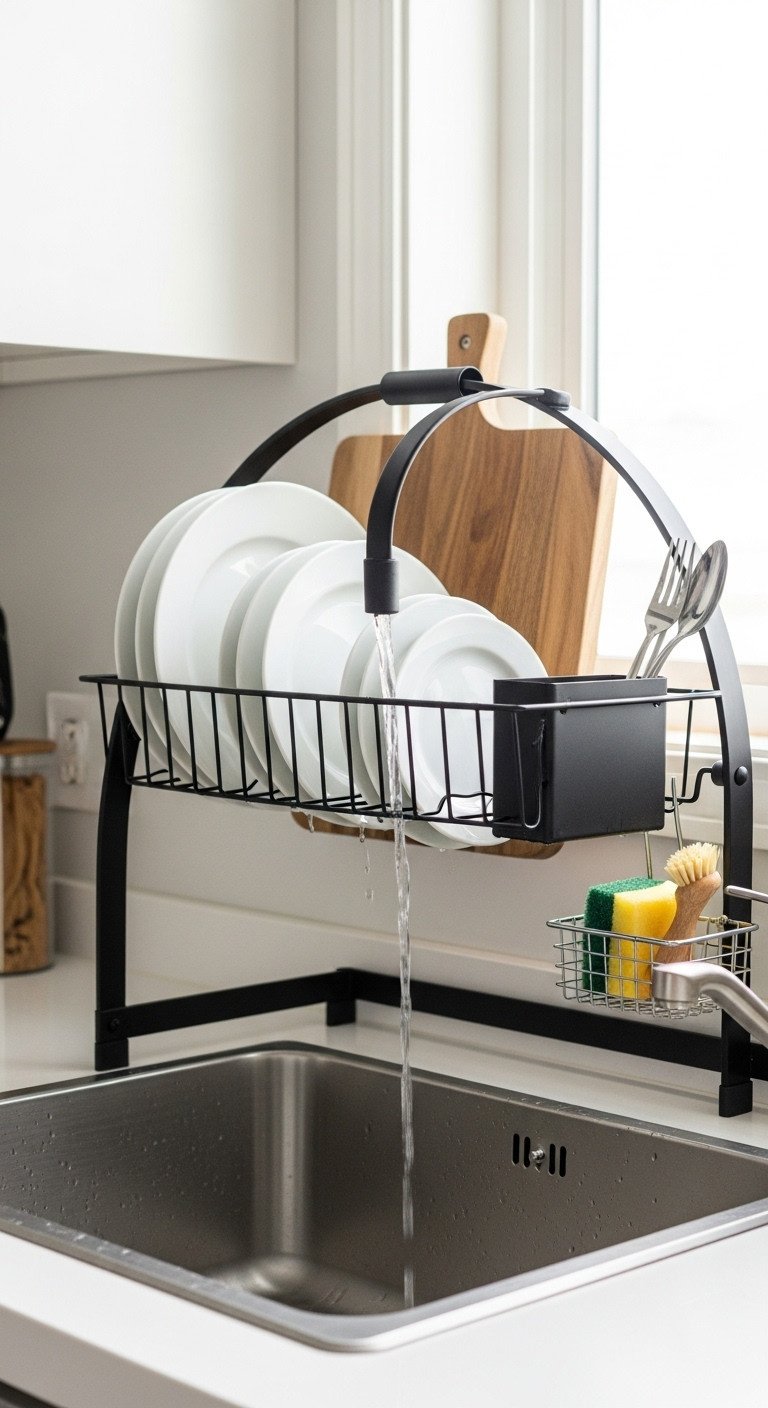
Pin this ultimate space-saving kitchen gadget!
A traditional dish rack is a notorious counter hog. An over-the-sink dish rack is a game-changer, utilizing the vertical space above your sink for drying dishes, washing produce, and even storing sponges. This one gadget can give you back a huge chunk of your workspace.
What You Need:
- An over-the-sink dish rack or a roll-up silicone drying rack
- A tape measure
How to Implement:
- Measure Carefully: Before buying, accurately measure the width of your sink basin and the height of your faucet. Ensure the rack you choose will fit over your sink and under any upper cabinets.
- Choose Your Style: Decide between a large, multi-tier rack that offers storage for utensils and cutting boards, or a simple, roll-up mat that can be stored away easily.
- Assemble (If Needed): Most larger racks require simple assembly. Follow the instructions to put it together.
- Position and Use: Place the rack over your sink. It’s now your dedicated drying zone, but it can also be used for washing vegetables or as an extra cooling rack, all while keeping your counters completely clear.
Pro-Tip: Look for a model with customizable hooks and baskets. This allows you to configure it perfectly for your specific needs, whether you need a spot for your soap, knives, or wine glasses.
4. Install Under-Cabinet LED Lighting
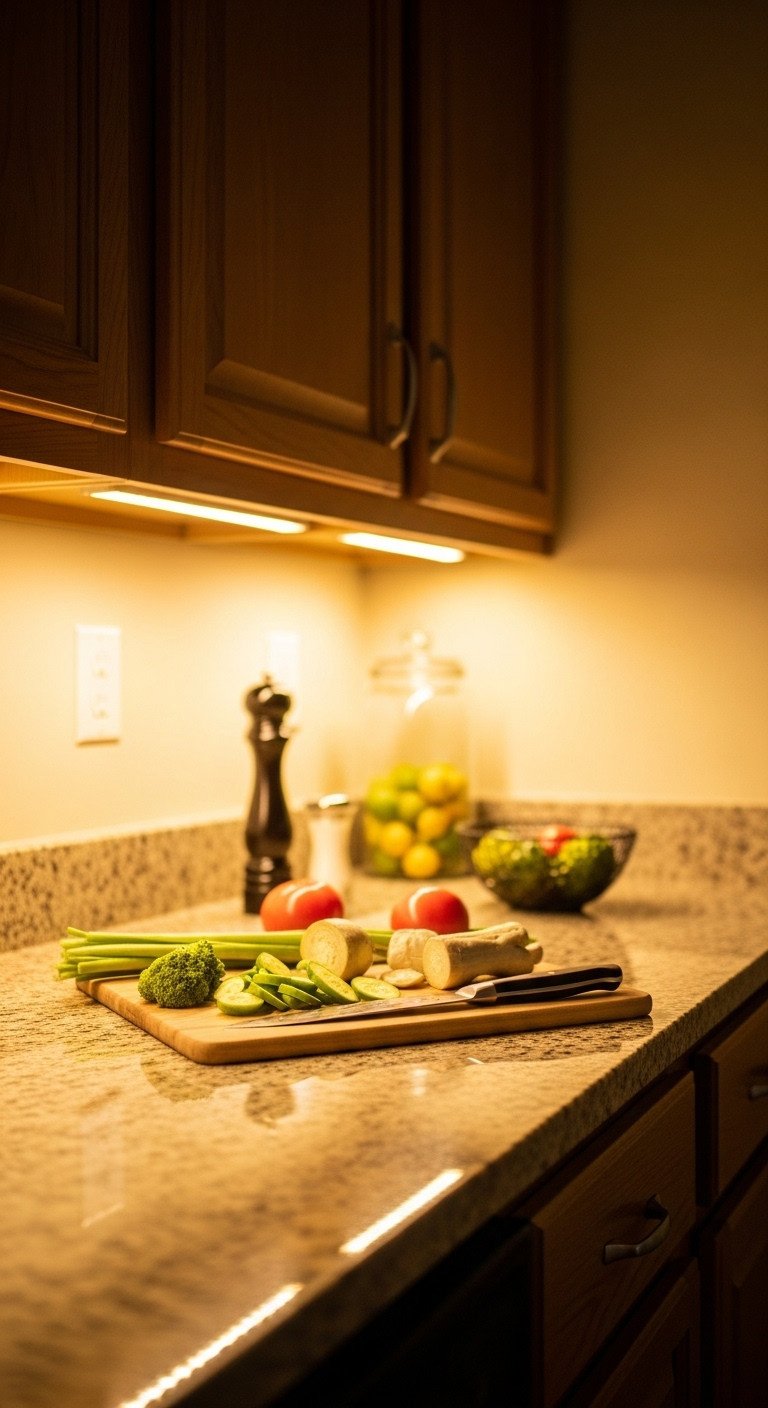
Save this bright idea to transform your kitchen!
Poor lighting can make even a well-organized kitchen feel dark and small. Under-cabinet LED lighting is a simple, high-impact upgrade that illuminates your countertops for safer food prep. This essential task lighting also adds a warm, inviting ambiance, making the entire kitchen feel more high-end.
Materials Needed:
- LED under-cabinet light kit (choose between plug-in, battery-operated for renters, or hardwired)
- Cleaning cloth and alcohol wipes
- Measuring tape
- Cable clips (for plug-in versions)
Step-by-Step Directions:
- Clean the Surface: Thoroughly wipe down the underside of your cabinets with an alcohol wipe to ensure the adhesive will stick properly. Let it dry completely.
- Measure and Cut: Measure the length of your cabinets and cut the LED strip light to size (most kits have designated cutting marks).
- Peel and Stick: Remove the adhesive backing and press the light strip firmly into place on the underside of the cabinet. It’s best to place it towards the front edge to illuminate the counter evenly without glare.
- Connect and Conceal: Connect the power source. If it’s a plug-in model, use small adhesive cable clips to run the wire neatly along the back of the cabinet to the nearest outlet.
- Enjoy the Light: Turn on your new lights and immediately see the difference in your workspace.
Pro-Tip: Choose a light kit with adjustable brightness and color temperature. A warmer light (around 2700K) is great for ambiance, while a cooler, brighter light (4000K) is better for task-heavy food prep.
5. Add a Rolling Kitchen Cart Island
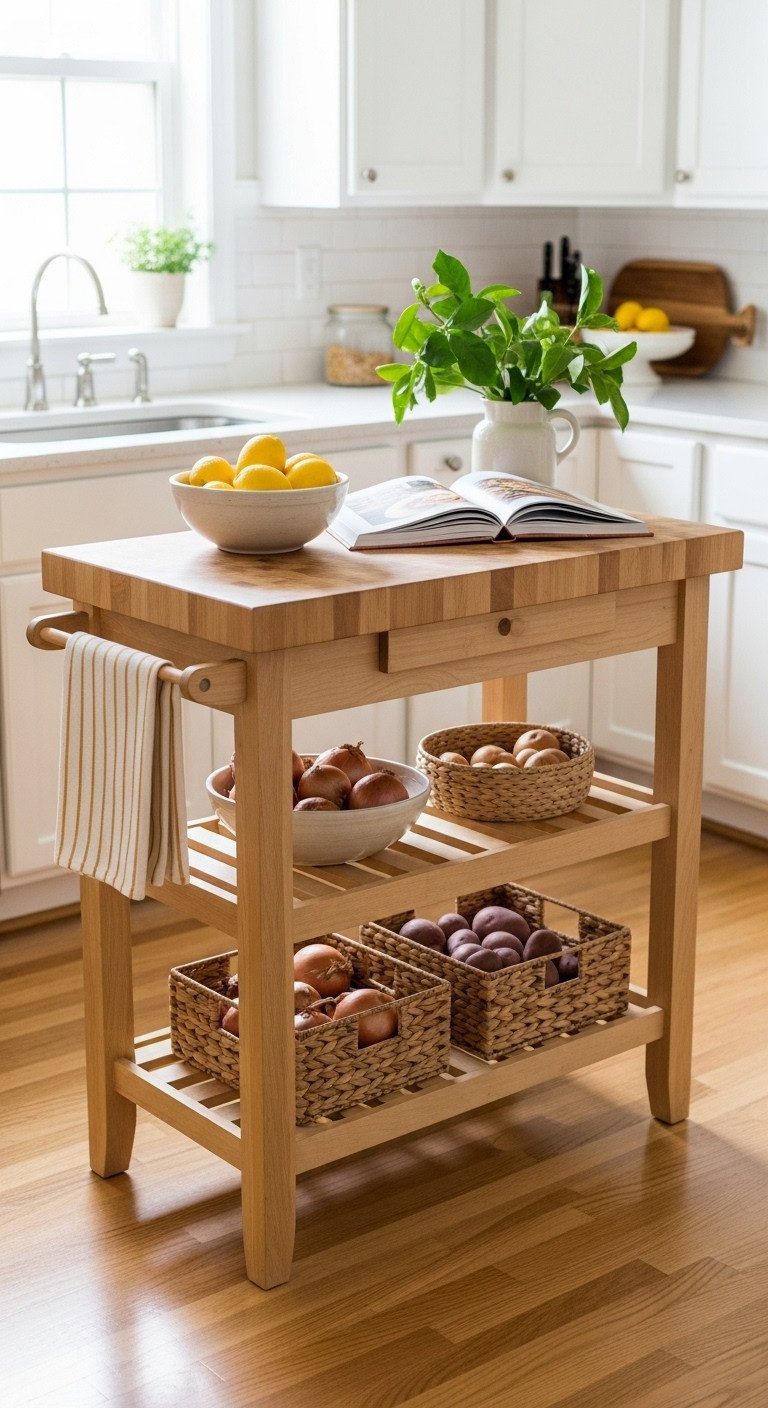
Pin this flexible solution for more counter space!
If you dream of a kitchen island but don’t have the space for a permanent one, a rolling cart is the perfect answer. It provides flexible, additional counter space and mobile storage that can be positioned where you need it or rolled out of the way entirely.
What You Need:
- A rolling kitchen cart that fits the scale of your kitchen. Look for one with a durable top like stainless steel or butcher block.
- Measuring tape to ensure it fits your space.
How to Implement:
- Measure Your Space: Before buying, measure the open floor space in your kitchen. Ensure there will be at least 3 feet of clearance on all sides for comfortable movement when the cart is in place.
- Choose Features: Select a cart based on your needs. Do you need more storage (shelves, drawers)? A wine rack? A towel bar? A drop-leaf for extra surface area?
- Assemble and Place: Follow the manufacturer’s instructions for assembly.
- Utilize Fully: Use the top for food prep, as a coffee station, or even a small dining spot. Use the lower shelves for storing small appliances, produce, or large bowls to free up cabinet space. You can roll it out of the way when you need more floor space.
Lesson Learned: Make sure to get a cart with locking caster wheels. This is a crucial safety feature that keeps it from rolling away while you’re chopping vegetables.
6. Upgrade with a Peel-and-Stick Backsplash
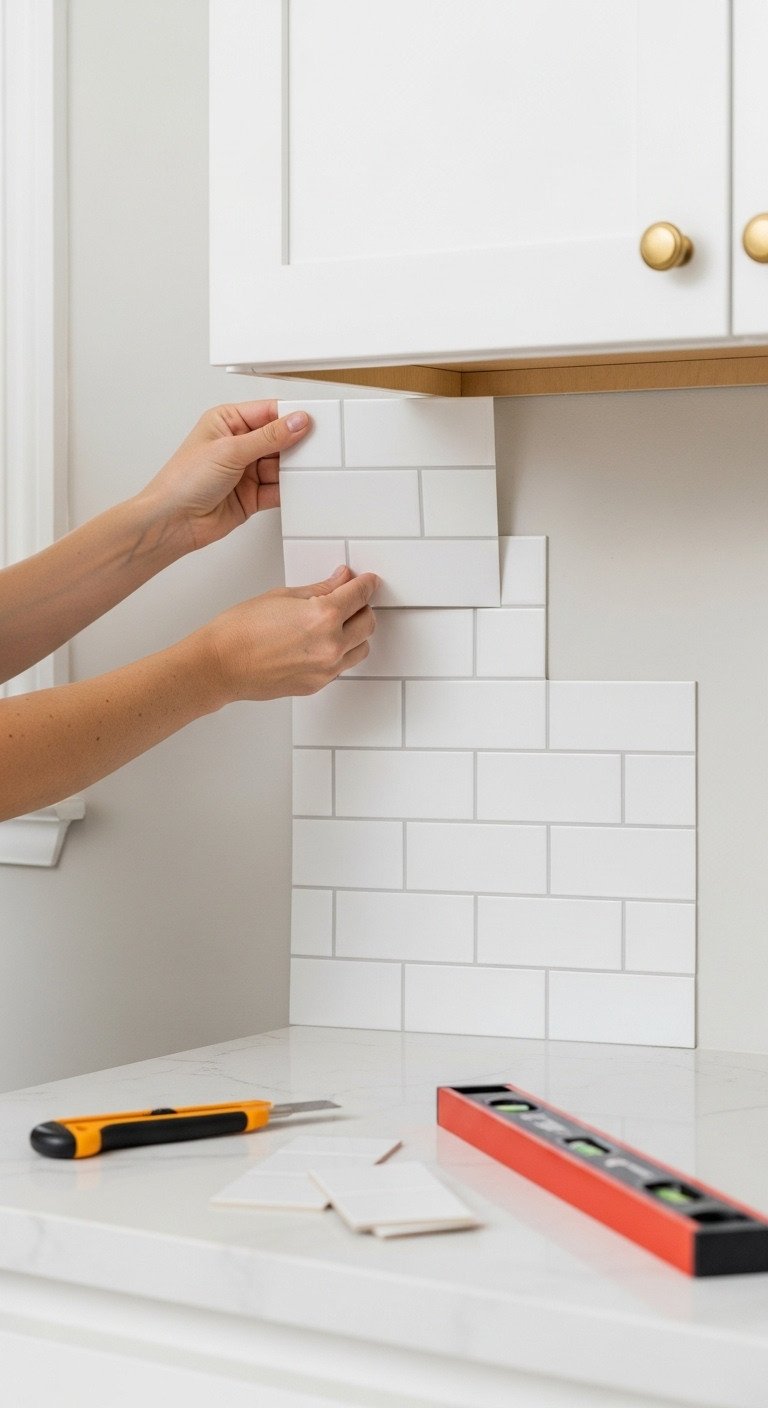
Save this renter-friendly hack for an instant kitchen upgrade!
A dated backsplash can bring down the entire look of your kitchen. High-quality peel-and-stick tiles offer a high-impact cosmetic upgrade that’s affordable, easy to install, and—best of all—completely removable. It’s the perfect renter-friendly solution for a fast and stylish update.
Materials Needed:
- High-quality peel-and-stick tile sheets
- Utility knife or sharp scissors
- Ruler or straight edge
- Level
- Cleaning spray and a cloth
Step-by-Step Directions:
- Prep the Wall: Clean your existing backsplash or wall thoroughly with a degreasing cleaner to remove any grime. Let it dry completely. A clean surface is essential for proper adhesion.
- Plan Your First Row: Start in a visible corner. Use a level to draw a faint guideline to ensure your first sheet goes on perfectly straight.
- Peel and Stick: Peel back the first few inches of the backing. Align the tile sheet with your guideline and press it firmly onto the wall, smoothing it out from the center to the edges to remove air bubbles.
- Overlap and Continue: Modern peel-and-stick tiles have overlapping grout lines. Align the next sheet over the designated area of the first one and continue across the wall.
- Cut to Fit: When you reach an outlet or the end of a wall, measure carefully and use a utility knife and straight edge to cut the tile sheet to fit perfectly.
Pro-Tip: Buy about 10% more tile than you think you need. This will cover any mistakes you might make while cutting. You can always return the unused sheets.
7. Swap Out Cabinet Hardware
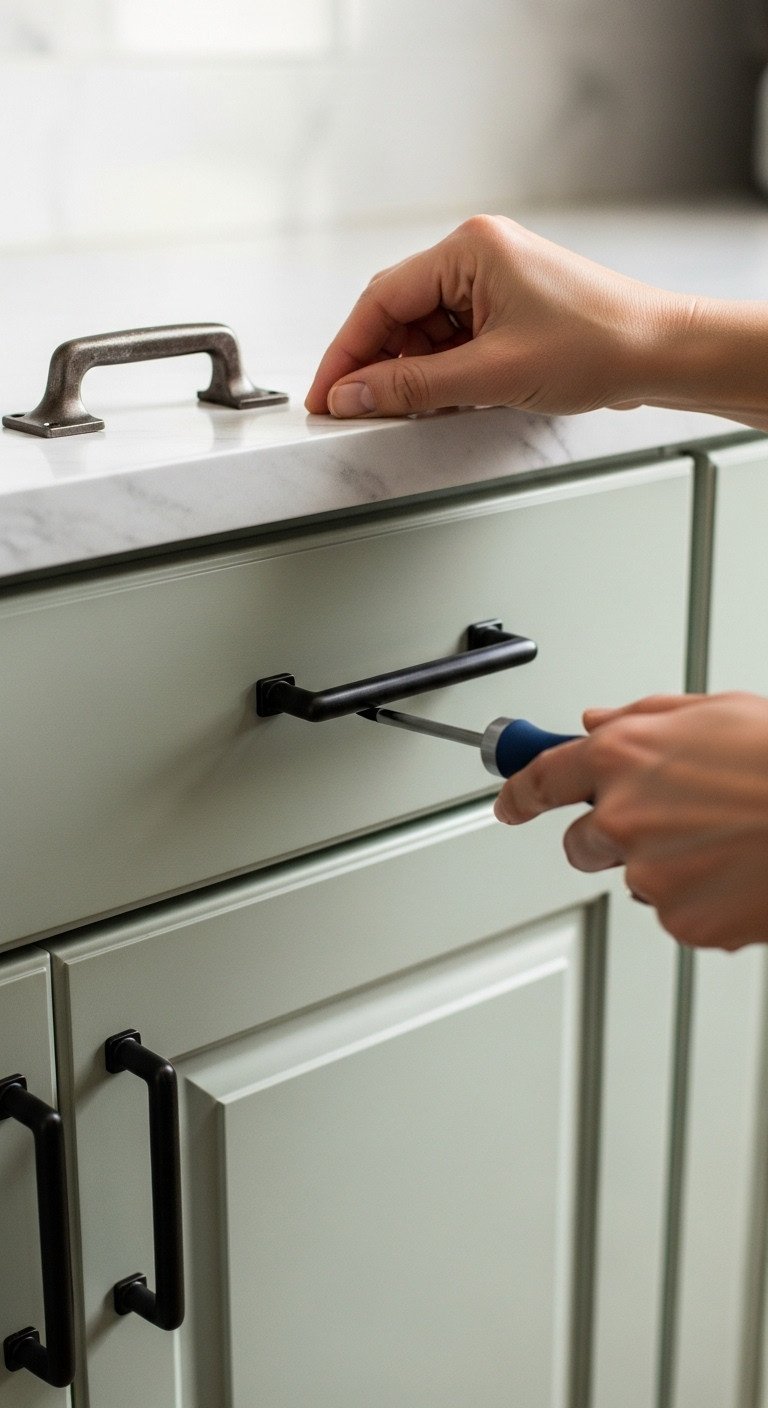
Pin this 30-minute kitchen refresh idea!
Never underestimate the power of new cabinet hardware. Swapping out dated knobs and pulls for a more modern style is one of the fastest, cheapest, and easiest ways to give your entire kitchen a facelift. This affordable update requires only a screwdriver and can be completed in under an hour.
What You Need:
- New cabinet knobs or pulls
- A screwdriver
- A measuring tape (if changing from knobs to pulls)
- The original hardware (for renters to store safely)
How to Implement:
- Measure First: Unscrew one of your existing handles or pulls. Measure the distance between the center of the two screw holes. This is your “center-to-center” measurement, and you must buy new pulls with the exact same measurement to avoid drilling new holes.
- Unscrew the Old: Use a screwdriver to remove all of the old knobs and pulls. Give the cabinet surface a quick wipe-down.
- Save the Originals (Renters!): If you are renting, place all the original hardware in a labeled bag and store it somewhere safe.
- Screw on the New: Simply screw your new hardware into the existing holes. This entire project can usually be done in under an hour and makes a massive visual impact.
Lesson Learned: Sometimes the screws that come with new hardware are too long or too short for your cabinet thickness. It’s a good idea to take one of your original screws to the hardware store to ensure you get the right length.
8. Create a Fold-Down Wall-Mounted Table
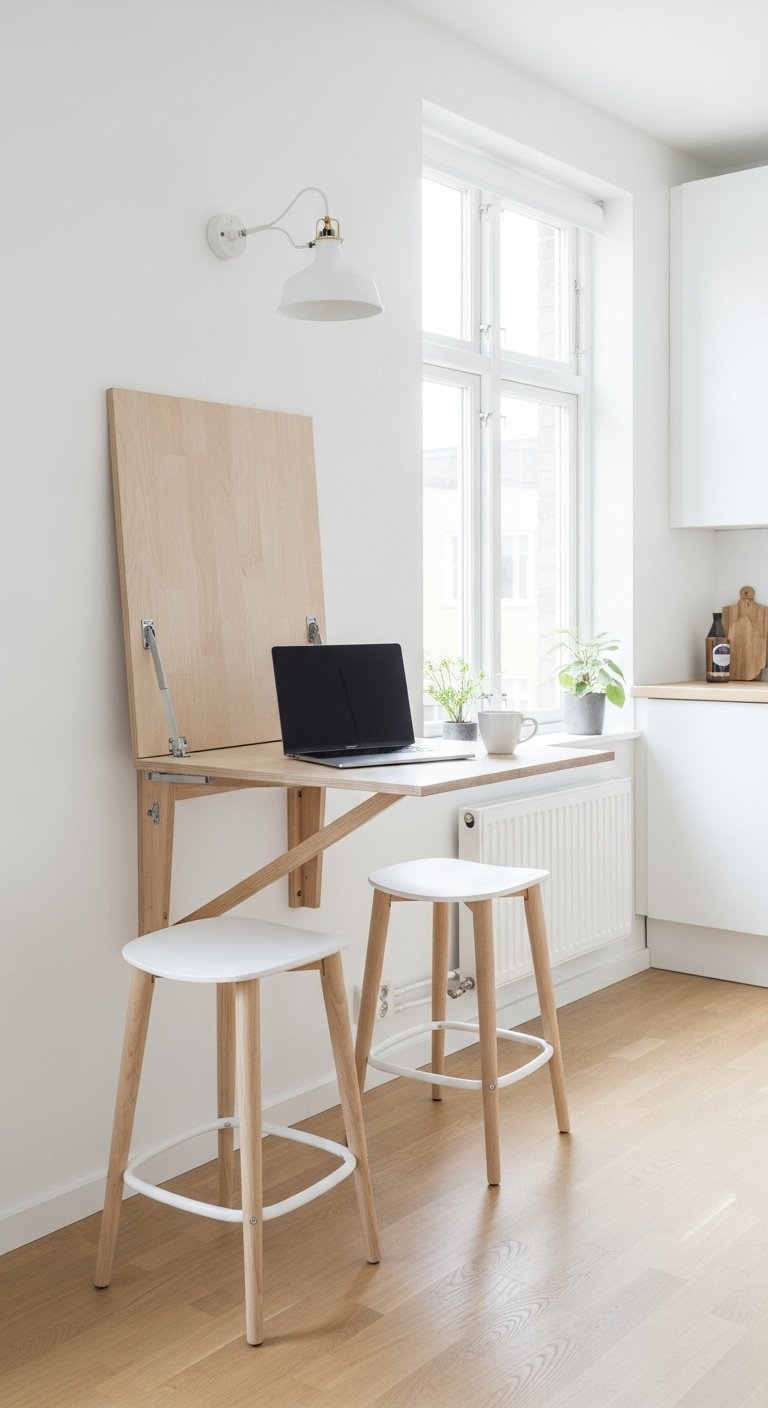
Save this brilliant idea for a tiny eat-in kitchen!
No room for a dining table? A wall-mounted drop-leaf table is a brilliant multi-functional solution. It provides a surface for eating or working when you need it and folds down flat against the wall to conserve floor space when you don’t. It’s the perfect way to create a compact dining area in a studio or eat-in kitchen.
Materials Needed:
- A wall-mounted drop-leaf table kit
- Stud finder
- Power drill
- Level
- Measuring tape and pencil
Step-by-Step Directions:
- Find a Clear Wall: Identify a section of wall in or near your kitchen that is free of obstructions.
- Determine the Height: Decide on the table height. Standard table height is around 30 inches, while counter height is 36 inches. Use a pencil and level to draw a straight line for the mounting bracket.
- Locate Studs: This is critical. A wall-mounted table must be secured to studs to support any weight. Use your stud finder to mark the stud locations along your guide line.
- Mount the Bracket: Following the product instructions, drill pilot holes and securely screw the table’s mounting bracket into the wall studs.
- Attach the Tabletop: Attach the tabletop to the bracket. Test the folding mechanism to ensure it operates smoothly. Pair with slim, tuck-under stools to maximize space.
Pro-Tip: This table can also double as extra prep space. Mount it at counter height (36 inches) to create a seamless extension of your existing workspace when needed.
9. Utilize the Inside of Cabinet Doors
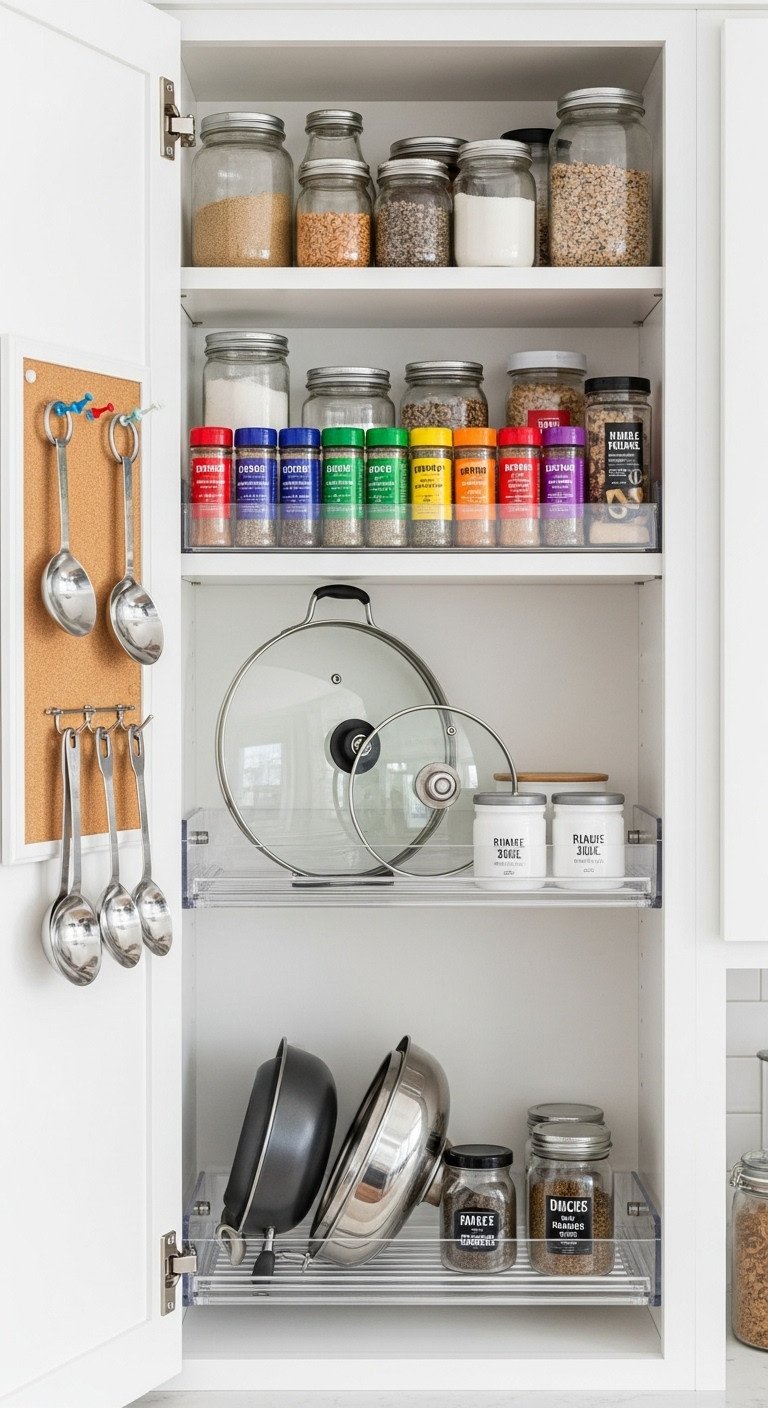
Pin this hidden storage hack to get organized!
The inside of your cabinet doors is some of the most underutilized real estate in your kitchen. This hidden space is perfect for slim organizers. You can add a door-mounted spice rack, a pot lid holder, or adhesive hooks for measuring spoons to free up valuable shelf space and keep small items perfectly organized.
What You Need:
- Slim, door-mounted spice racks
- A cabinet door pot lid organizer
- Small, adhesive hooks or a cork tile and pushpins
- Screwdriver or strong adhesive strips
How to Implement:
- Assess Your Doors: Open your cabinets and see which doors have potential. Ensure that any organizer you add won’t interfere with the shelves or items inside when the door is closed.
- Install a Spice Rack: Attach a narrow rack designed for cabinet doors to hold your spices. This frees up an entire shelf and makes them easy to find.
- Tame Pot Lids: Mount a dedicated pot lid holder on the inside of a lower cabinet door near your stove. This solves the problem of messy, clanging stacks of lids.
- Hang Utensils: Use small adhesive hooks or a piece of cork tile to hang measuring cups and spoons. They’ll be perfectly organized and always within reach.
Lesson Learned: Before permanently screwing anything in, close the door slowly with the organizer held in place to make sure it doesn’t hit any shelves. Use a pencil to mark the exact placement before you drill.
10. Hang a Stylish Pot Rack
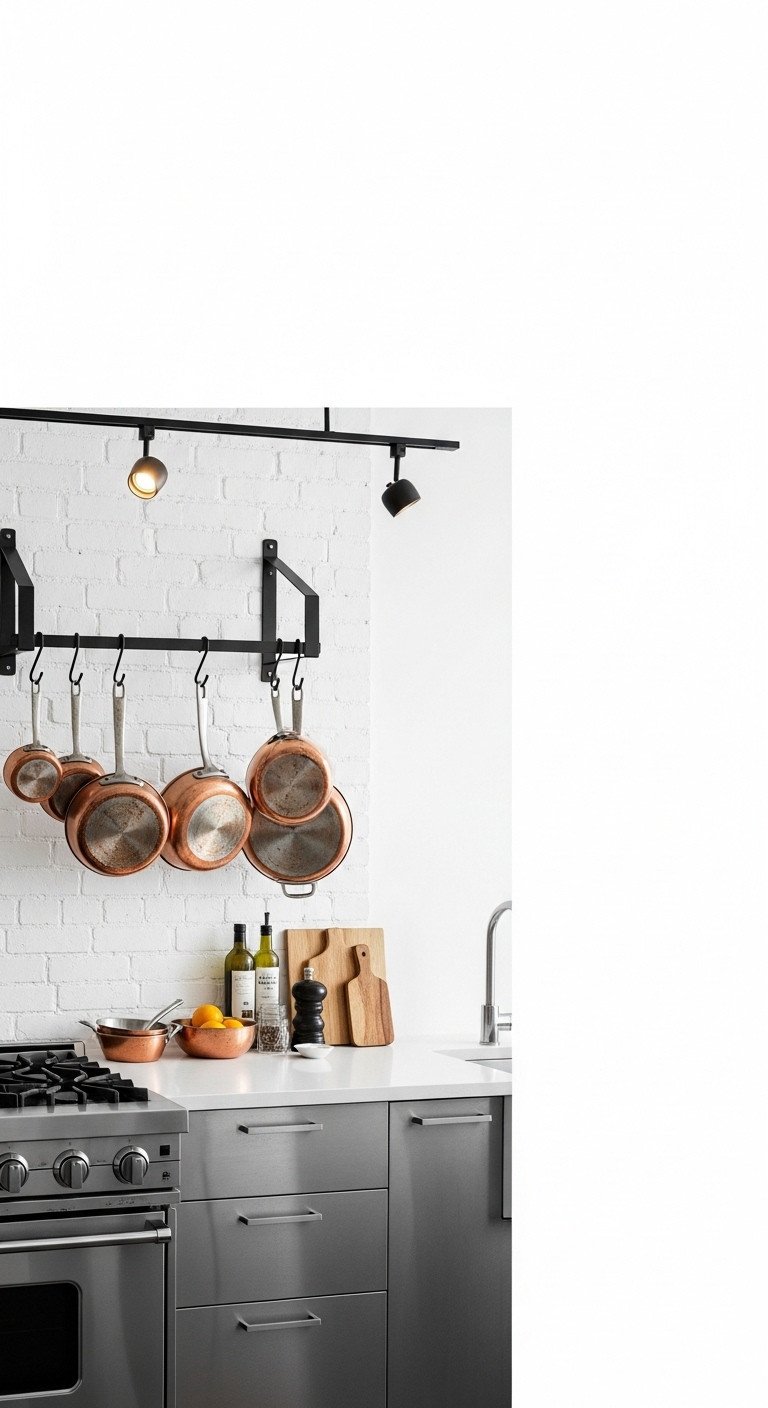
Save this idea to turn your cookware into art!
Bulky pots and pans can monopolize an entire cabinet. A stylish pot rack—either wall-mounted or hanging from the ceiling—frees up that precious cabinet space and turns your cookware into functional decor. It keeps your most-used items accessible and adds a professional, stylish element to your kitchen.
Materials Needed:
- A wall-mounted or ceiling-mounted pot rack
- S-hooks
- Stud finder
- Heavy-duty wall anchors or toggle bolts
- Power drill
- Level
Step-by-Step Directions:
- Choose Your Type: Decide between a wall-mounted rack (great for a clear wall) or a ceiling-mounted one (perfect for over an island or peninsula).
- Find a Secure Location: This is the most important step. A rack full of pots is very heavy. You must locate ceiling joists or wall studs to mount it securely. Use a stud finder.
- Mark and Drill: Use a level to mark your mounting points directly over the studs or joists. Drill pilot holes.
- Install Securely: Use the heavy-duty hardware provided (or upgrade to toggle bolts for extra security) to mount the rack. Tug on it firmly to ensure it is completely stable.
- Hang Your Cookware: Use S-hooks to hang your most-used (and most attractive!) pots and pans. Keep lids on the pots or use a separate lid organizer.
Pro-Tip: This solution works best if you have a matching or aesthetically pleasing set of cookware. If your pots and pans are mismatched, consider a pot rack with a built-in shelf where you can stack them instead of hanging them.
11. Decant Pantry Items into Uniform Containers
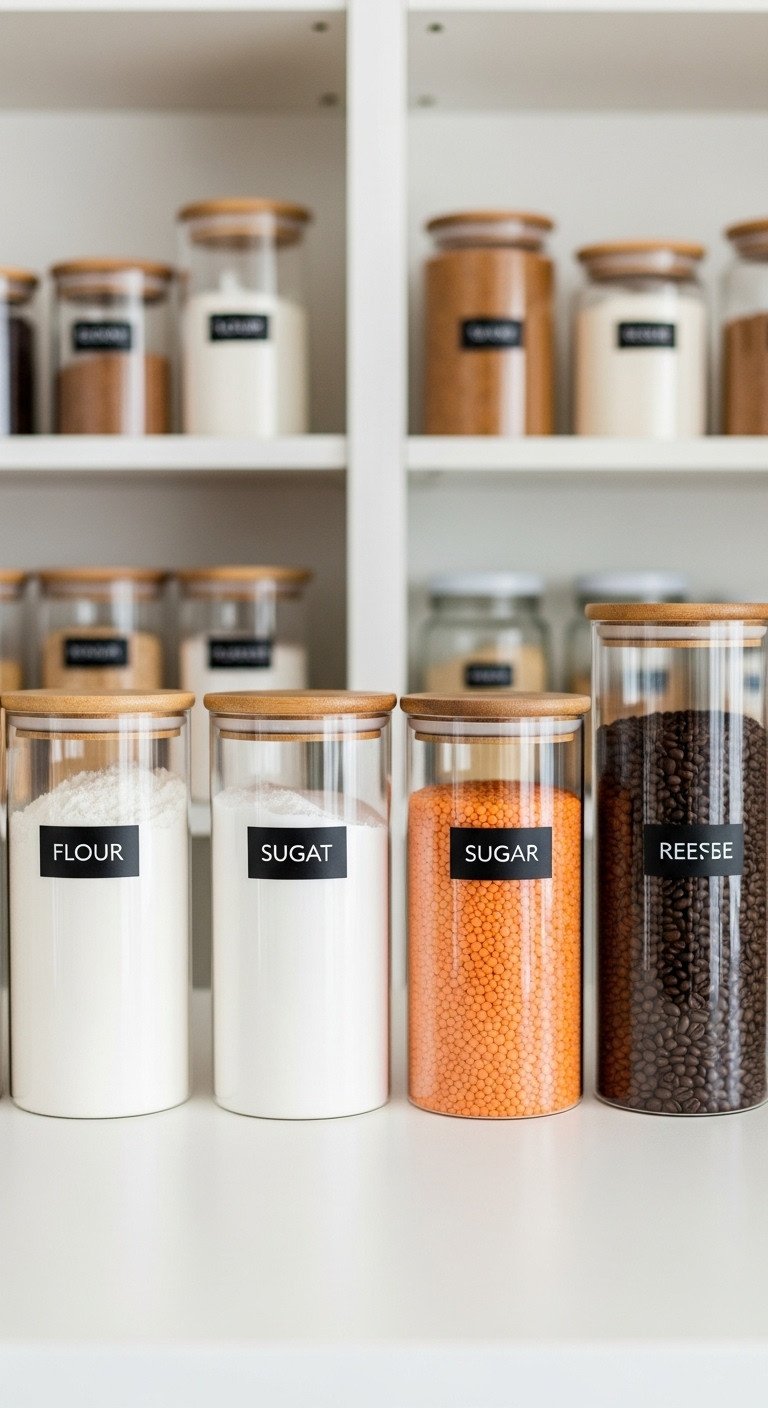
Pin this satisfying hack for a beautiful and functional pantry!
Half-empty bags and mismatched boxes create visual chaos in your cabinets. Decanting dry goods like pasta, flour, and cereal into uniform, airtight containers instantly reduces clutter. This kitchen organization hack makes it easy to see what you have at a glance and creates a calm, streamlined aesthetic.
What You Need:
- A set of clear, airtight food storage containers in various sizes
- A label maker or pre-made pantry labels
- Funnels for easy pouring
How to Implement:
- Take Inventory: Before buying containers, assess what you need to store. Make a list of all your dry goods like flour, sugar, pasta, rice, cereal, nuts, and coffee.
- Choose Your Containers: Select a matching set of containers. Clear containers are best so you can see the contents. Square or rectangular shapes are more space-efficient on shelves than round ones.
- Decant Everything: Transfer your food from its bulky, mismatched packaging into the new containers. Use funnels for powders and grains to minimize mess.
- Label Clearly: Add a simple, clear label to each container. This is crucial for telling the difference between flour and powdered sugar!
- Arrange Neatly: Place the containers back on your shelves. The uniform look will instantly reduce visual clutter and make your cabinets or pantry feel more spacious and organized.
Pro-Tip: Use a chalk marker on a small section of the back of each container to write the expiration date from the original packaging. This way, the date is hidden from the front but still easy to check.
Key Takeaways: Your Quick Guide to a Better Apartment Kitchen
- Go Vertical: The fastest way to gain storage is to use your wall space. Install shelves up to the ceiling.
- Clear the Counters: Use magnetic strips and over-the-sink racks to get everything off your valuable prep surfaces.
- Light it Up: Good under-cabinet lighting is a non-negotiable. It makes the space feel bigger and more functional.
- Focus on Flexibility: For renters, rolling carts and peel-and-stick products offer huge impact without permanent changes.
- Uniformity is Calming: Decanting pantry items and swapping hardware creates a cohesive, less cluttered look instantly.
People Also Ask About Apartment Kitchen Design
How can I make my small apartment kitchen look bigger?
To make a small kitchen look bigger, focus on light and lines. Use a light color palette (white, light gray, pastels), install excellent under-cabinet lighting to eliminate shadows, and use reflective surfaces like a glossy backsplash. Drawing the eye upward with vertical shelving also creates an illusion of height and space.
What are the best renter-friendly kitchen upgrades?
The best renter-friendly upgrades are temporary and non-damaging. Top choices include applying high-quality peel-and-stick backsplashes, covering countertops with contact paper, swapping out cabinet hardware (and saving the originals), and using freestanding storage like rolling carts. Always check your lease first.
How can I add counter space to a kitchen with none?
You can add counter space by introducing new surfaces. The most effective ways are adding a rolling kitchen cart or a small freestanding island, using a large cutting board that fits over your sink basin, or installing a wall-mounted drop-leaf table that can be folded away.
Is it expensive to update an apartment kitchen?
It doesn’t have to be. A cosmetic update can be very affordable. High-impact, low-cost projects include changing cabinet hardware, installing a peel-and-stick backsplash, and adding plug-in under-cabinet lighting. A full renovation, however, can be costly.
Final Thoughts
Even the smallest kitchen has incredible potential to be a beautiful, functional, and joyful space. You don’t have to live with a room that frustrates you. As you’ve seen, a few smart changes—from adding vertical storage to upgrading your lighting—can completely transform not just your kitchen, but your entire daily routine. It’s about making your space work for you.
Which of these ideas are you most excited to try in your own kitchen? Let us know in the comments below
Last update on 2025-11-19 at 03:34 / Affiliate links / Images from Amazon Product Advertising API
